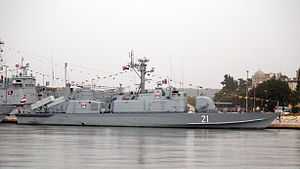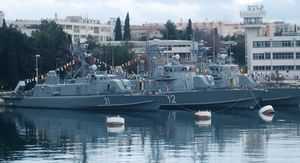Končar-class missile boat
 Šibenik (RTOP-21) of the Croatian Navy. Note that unlike other Končar-class ships, Šibenik is armed with two RBS-15. | |
| Class overview | |
|---|---|
| Builders: | Tito's Shipyard Kraljevica, Kraljevica, SR Croatia |
| Operators: |
|
| Succeeded by: | Kralj class |
| In commission: | 1977–present |
| Completed: | 6 |
| Active: | 3 |
| Laid up: | 3 |
| General characteristics (as completed) | |
| Type: | Missile boat |
| Displacement: | Full: 271 t (267 long tons) |
| Length: | 44.9 m (147 ft 4 in) |
| Beam: | 8.4 m (27 ft 7 in) |
| Draft: | 2.6 m (8 ft 6 in) |
| Propulsion: |
|
| Speed: |
|
| Endurance: | 5 to 7 days |
| Complement: | 30 |
| Armament: | |
The Končar-class is a class of six missile boats built for the Yugoslav Navy during the late 1970s at Tito's Shipyard Kraljevica, SR Croatia. The boats featured a mixture of Western and Eastern equipment, including Soviet anti-ship missiles and Swedish guns.
During the Croatian War of Independence one ship, Vlado Ćetković, was captured by Croatian forces while being overhauled. It was eventually commissioned with the Croatian Navy as Šibenik and is still in use. The remaining five ships were relocated to Montenegro, entering service with the new FR Yugoslav Navy, with three of them being decommissioned in the early 2000s. The last two ships of the class are planned to be modified as patrol boats for service with the Montenegrin Navy.
Description
The Končar class was developed by the Brodarski institut (BI) from Zagreb. The six-strong class was built at the Tito's Kraljevica Shipyard from 1977 to 1979 with all six ships being named after People's Heroes of Yugoslavia. The ships measure 44.9 m (147 ft 4 in) in length, with a 8.4 m (27 ft 7 in) beam and 2.6 m (8 ft 6 in) draught. The hull, similar to the Swedish Spica class, is made of steel with an aluminium superstructure. Fully loaded they displace 271 t (267 long tons) and are manned by a crew of 30.[1][2]
The class utilizes a CODAG engine configuration for propulsion. Mounted on four shafts, two MTU 16V 538 TB91 diesel engines are used for economical cruising while two RR Marine Proteus 52 M gas turbines are used for achieving high speeds. Cruising speed is 22 knots (41 km/h; 25 mph) while the maximum achievable speed is 38–40 knots (70–74 km/h; 44–46 mph). Travelling at a near maximum speed of 38 knots, the ships have a maximum range of 380–490 nautical miles (700–910 km; 440–560 mi). Powered by diesel engines only and travelling at a speed of 22–23 knots (41–43 km/h; 25–26 mph) they have a range of 780–870 nautical miles (1,440–1,610 km; 900–1,000 mi), with exact numbers varying from source to source.[1][3][4] Endurance is between five to seven days.[3][5]
Gun armament of the class consists of two Bofors 57 mm (2.2 in)/70 Mk1 gun mounted on the bow and towards the stern. During the development phase, the designers planned on using French Exocet anti-ship missiles as the class's main weapon system. However, due to the high price the French asked for the missile, possibly because of political reasons, the project was changed and two Soviet P-20 (SS-N-2B) were used instead. Self-defense measures include two Wallop Barricade chaff launchers.[6][1]
Ships
| Name | Pennant number[7] | Namesake | Builder[2] | Launched[8][1] | Commissioned[8][1] | Fate |
|---|---|---|---|---|---|---|
| Rade Končar | RTOP-401 | Rade Končar | Tito's Shipyard Kraljevica, Kraljevica, SR Croatia, SFR Yugoslavia | 16 October 1976 | April 1977 | sold to Kenya[9] |
| Vlado Ćetković | RTOP-402 | Vlado Ćetković | 20 August 1977 | March 1978 | In service with the Croatian Navy[4] | |
| Ramiz Sadiku | RTOP-403 | Ramiz Sadiku | 24 April 1978 | September 1978 | scrapped[10] | |
| Hasan Zahirović-Laca | RTOP-404 | Hasan Zahirović-Laca | 9 November 1978 | December 1978 | decommissioned; fate unknown[11] | |
| Jordan Nikolov Orce | RTOP-405 | Jordan Nikolov Orce | 26 April 1979 | August 1979 | In service with the Montenegrin Navy[12] | |
| Ante Banina | RTOP-406 | Ante Banina | 23 November 1979 | November 1980 | In service with the Montenegrin Navy[12] |
Service

During the late 1980s and early 1990s Rade Končar and Vlado Ćetković underwent a modernization program which included removing the stern 57 mm Bofors and installing a Soviet AK-630 CIWS. At the start of the Croatian War of Independence, Vlado Ćetković was captured by Croatian forces in Šibenik while being overhauled. It was commissioned with the Croatian Navy on 28 September 1991 as Šibenik (RTOP-21). Sometime between 1991 and 1994 Šibenik underwent a refit that included removing the P-20 launchers and installing two mounts for up to four Swedish built RBS-15 anti-ship missiles. As of 2014 Šibenik is in active service with the Croatian Navy.[1][11][5]
The rest of the class remained in hands of the Yugoslav Navy. On 6 October, Hasan Zahirović-Laca along with the Koni-class frigate Koper (VPBR-32) took part in the Battle of Zadar. Croatian coastal batteries in the area operated two captured Bofors 40 mm (1.6 in) guns with only one of them being in position to open fire on the ships. The initial five to six rounds fired at Hasan Zahirović-Laca missed their target, after which the gun malfunctioned. After a quick repair, the missile boat was targeted again, with three rounds hitting the stern section and causing no damage because the gun crew didn't have armor-piercing ammunition at their disposal.[13] Two Končar-class missile boats also took part in the Battle of the Dalmatian Channels. Jordan Nikolov-Orce, operating under the codename "Parak", and Ante Banina, under the codename "Pakra", were members of the tactical group "Vis" which was tasked with enforcing a naval blocade of the city of Split and the surrounding islands.[14] With the Yugoslav Peoples Army endings its campaign in Croatia, all ships of the class, excluding Vlado Ćetković, were relocated to Montenegro where they were commissioned with the new FR Yugoslav Navy of Serbia and Montenegro.[11]

During the mid 1990s, Ramiz Sadiku was docked for a major overhaul and reconstruction. However, due to the lack of funds the work was never completed and the boat was decommissioned and eventually sold for scrap.[11][9] The boat's superstructure, propulsion, sensors and weapon systems were dismantled, after which the new owner moved the boat to an underground naval dock on the Luštica peninsula. The boat remained there for several years, before its deteriorating condition caused it to sink inside the dock. The wreck was raised in 2014 and towed to Zelenika where it was broken up to smaller segments which were then transported to the Nikšić steel factory.[15]
In June 2006, Hasan Zahirović-Laca sailed from Boka Kotorska to Italy to participate in the international naval exercise "Adrion Livex 06". The boat left port under the flag of the Navy of Serbia and Montenegro, but because Montenegro declared its independence on 6 June while the boat was still out on exercise, Hasan Zahirović-Laca became the first ship outside of Montenegrin waters to display the flag of the new country.[9] The boat was decommissioned later that year, along with the first boat of the class, Rade Končar.[11] The latter was sold to Kenya in 2014 for an undisclosed price. The Kenyan Navy plans on striping the boat of its guns and fire-control systems which would then be overhauled and installed on the offshore patrol vessel KNS Jasiri. Rade Končar itself is then expected to be rebuilt and used by the Navy as a patrol boat. The fate of Hasan Zahirović-Laca remains unknown.[9]
In 2013, the Ministry of Defense of Montenegro issued the Strategic Overview of the Defense of Montenegro (Strategijski pregled odbrane Crne Gore) in which it was stated that until sufficient funds to acquire new patrol boats were made available, the Montenegrin Navy would modify two Končar-class missile boats, RTOP-405 and RTOP-406, for use as patrol boats.[12] In February 2014 it was revealed that the Montenegrin Ministry of Defense chose the Brodarski institut from Zagreb to create the project documentation for the modification of the missile boats. As planned, the boats would be stripped of their missile launchers and the aft Bofors gun to allow a rigid-hulled inflatable boat[16] to be carried.
See also
Notes
- ↑ 1.0 1.1 1.2 1.3 1.4 1.5 Saunders 2004, p. 652.
- ↑ 2.0 2.1 Shipyard Kraljevica – List of delivered vessels 1946. – 2007..
- ↑ 3.0 3.1 Brodovi Flote HRM u vježbi "Phiblex".
- ↑ 4.0 4.1 Flotila HRM.
- ↑ 5.0 5.1 Wertheim 2007, p. 146.
- ↑ Jelavić 2003.
- ↑ Gardiner 1995, p. 647.
- ↑ 8.0 8.1 Saunders 2004, p. 163.
- ↑ 9.0 9.1 9.2 9.3 Luković 17 November 2014.
- ↑ Luković 28 October 2011.
- ↑ 11.0 11.1 11.2 11.3 11.4 Šoštarić 7 August 2008.
- ↑ 12.0 12.1 12.2 Strategijski pregled odbrane Crne Gore.
- ↑ Klarica 5 October 2010.
- ↑ Bernadić 2013.
- ↑ Luković 11 December 2014.
- ↑ Krnić 14 February 2014.
References
- Books
- Gardiner, Robert (1995). Conway's All the World's Fighting Ships, 1947–1995. Naval Institute Press. ISBN 978-0-85177-605-7.
- Saunders, Stephen (2004). Jane's Fighting Ships 2004–2005. Jane's Information Group Limited. ISBN 0-7106-2623-1.
- Wertheim, Eric (2007). The Naval Institute Guide to Combat Fleets of the World, 15th Edition: Their Ships, Aircraft And Systems. Naval Insitute Press. ISBN 978-1-59114-955-2.
- News reports
- Bernadić, Stjepan (October 2013). "Oproštaj bez zvuka sirene" [Farewell without the sounds of sirens]. Hrvatski vojnik (in Croatian) (Ministry of Defence) (432). ISSN 1333-9036.
- Klarica, Siniša (5 October 2010). "Dani ponosa i slave – kako su gardisti otjerali ratne topovnjače iz Zadra" [Days of pride and glory – how the guardsmen run off the gunboats from Zadar]. Zadarski list. Retrieved 9 April 2014.
- Krnić, Denis (14 February 2014). "Brodarski institut iz Zagreba obnavlja crnogorske topovnjače" [Brodarski institut from Zagreb renewing Montenegrin missile boats]. Slobodna Dalmacija. Retrieved 9 April 2014.
- Luković, Siniša (28 October 2011). "Pristaništa na Luštici propadaju umjesto da služe pomorskoj floti" [Luštica anchorage deteriorating while it should be used by the Navy Fleet]. Vijesti. Retrieved 9 April 2014.
- Šoštarić, Eduard (7 August 2008). "Bitka za jedrenjak 'Jadran'" [Battle for the sailboat 'Jadran']. Nacional. Retrieved 31 January 2014.
- Luković, Siniša (17 November 2014). "Vojska CG prodala topovnjaču Keniji" [Army of Montenegro sold a missile boat to Kenya]. Vijesti. Retrieved 13 December 2014.
- Luković, Siniša (11 December 2014). "Nestaje još jedan ratni brod bivše Ratne mornarice" [Another warship of the former Yugoslav Navy disappears]. Vijesti. Retrieved 13 December 2014.
- Other sources
- "Brodovi Flote HRM u vježbi "Phiblex"" [Ships of the HRM Fleet in the "Phiblex" exercise]. Hrvatski vojnik. Retrieved 6 April 2014.
- "Flotila HRM" [Navy Flotilla]. Armed Forces of the Republic of Croatia. Retrieved 30 March 2014.
- Jelavić, Tino (December 2003). "Razmatranja o JNA" [Contemplations regarding the JNA]. Polemos (Croatian Sociological Association) VI (11–12): 163–175. Retrieved 17 March 2014.
- "Shipyard Kraljevica – List of delivered vessels 1946. – 2007." (PDF). Kraljevica Shipyard. Retrieved 13 March 2014.
- "Strategijski pregled odbrane Crne Gore" [Strategic Overview of the Defense of Montenegro]. Ministry of Defense. Retrieved 10 April 2014.
| ||||||||||||||||||||||||||||||||||||||||||||||